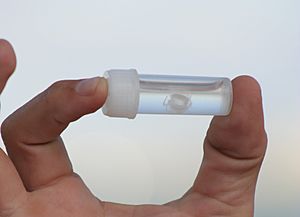Malo kingi facts for kids
Quick facts for kids Malo kingi |
|
|---|---|
 |
|
| Scientific classification | |
| Genus: |
Malo
|
| Species: |
kingi
|
The Malo kingi, also known as the common kingslayer, is a type of Irukandji jellyfish. It was first officially described by scientists in 2007. This tiny jellyfish is one of four species in the Malo group. Even though it's smaller than your thumbnail, it has some of the most powerful venom in the world. Like other Irukandji jellyfish, its sting can cause Irukandji syndrome. This syndrome brings on severe pain, vomiting, and a quick rise in blood pressure.
This jellyfish was named after Robert King. He was a tourist from the United States who sadly died after being stung while swimming near Port Douglas, Queensland, Australia.
Contents
What Does Malo kingi Look Like?
M. kingi are a kind of Irukandji jellyfish. They are shaped like a bell and are clear, so you can see right through them. Their bell is about 31 millimeters (just over an inch) tall.
Some of these jellyfish have special "halo-like" rings around their tentacles. They also have light purple bumps called nematocyst warts. These warts hold the stinging cells. M. kingi have a unique frown-shaped opening and two eyes that can see light. Their stinging cells on the main tentacles are shaped like clubs.
Where Does Malo kingi Live?
You can find M. kingi mainly in Queensland, Australia. They are quite rare. Only a small number are seen each year, usually in late summer and early winter. The jellyfish without the "halo" rings are found more often than those with them.
How Dangerous Is Its Sting?
M. kingi jellyfish are very small and hard to spot in the water. This makes it difficult for swimmers to see them before they get stung. Their venom is extremely strong. The death of Robert King is the only known case where their venom has been deadly.
However, many people have been stung by them. Lisa-Ann Gershwin, a marine expert from Australia, was stung while studying M. kingi. Her hands blistered badly, and her skin peeled off a week later. Another young girl who was stung felt very sick and had intense pain.
Scientists think that as a M. kingi jellyfish gets older, its venom might become stronger. They also believe that the jellyfish without the "halo" rings might have less powerful venom.
The Story of Robert King
In 2002, Robert King, a tourist from the U.S., was snorkeling in Queensland, Australia. He was stung by a M. kingi jellyfish. Sadly, Mr. King died because the sting caused his blood pressure to rise very high, leading to bleeding in his brain.
His death made people more aware of the dangers of M. kingi. It also led to more research about these jellyfish. The species was named Malo kingi in his honor.
See also
 In Spanish: Malo kingi para niños
In Spanish: Malo kingi para niños

